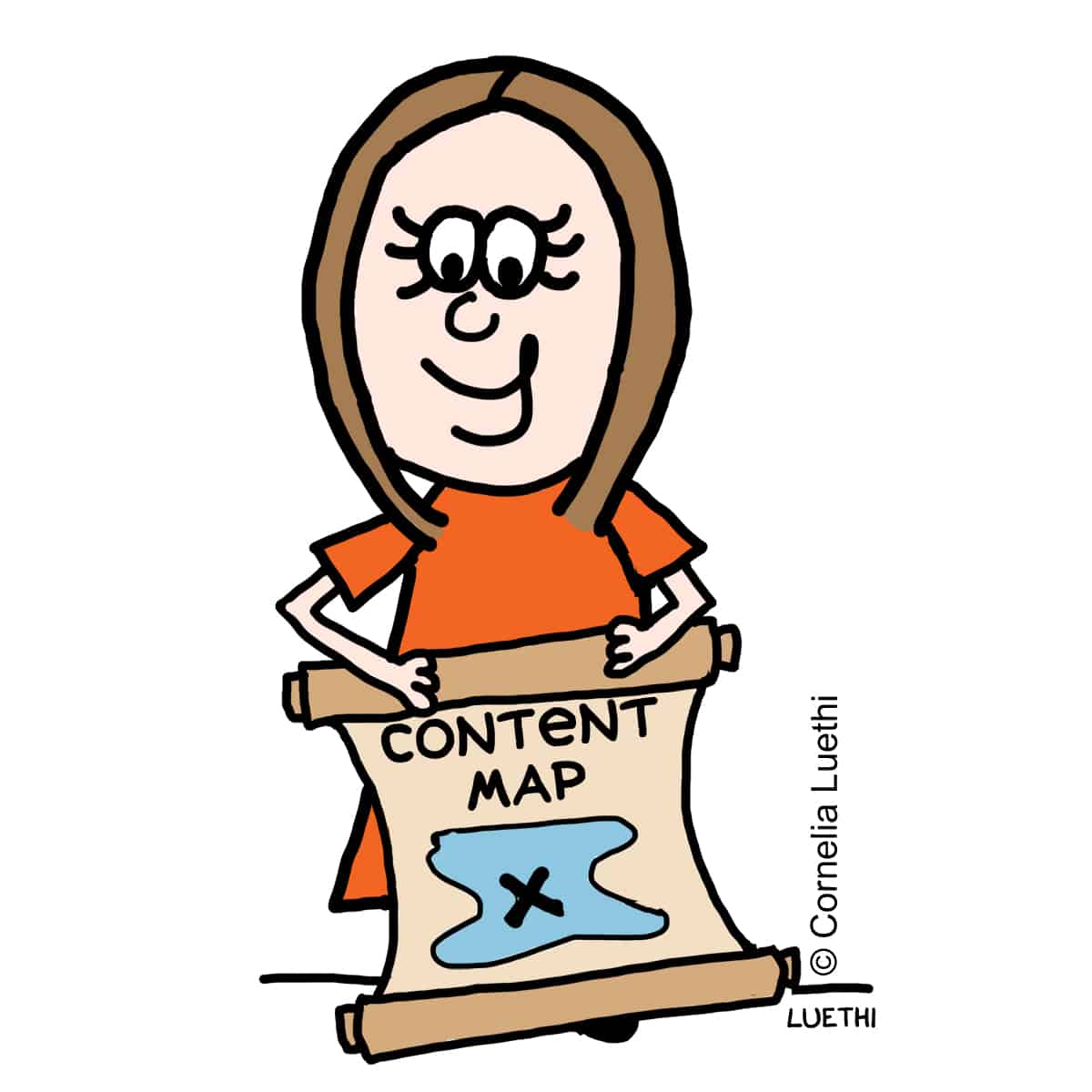 All too often, business owners take a scattergun approach to content creation. For example, you have a brainwave about a topic (or maybe you’ve discovered a great keyword), and off you go and write a blog article.
All too often, business owners take a scattergun approach to content creation. For example, you have a brainwave about a topic (or maybe you’ve discovered a great keyword), and off you go and write a blog article.
That’s all well and good – especially if the article you’ve written addresses a question or problem your prospects regularly face.
But if you’re serious about content creation, it pays to look at it strategically, so you’re covering all the bases. The risk with the scattergun approach is that you’ll hit some targets repeatedly, but won’t get anywhere near others – because you haven’t identified they’re there.
Strategic content creation requires content mapping. Here are the four steps involved in creating a content map.
Four steps to creating your content map
Step 1: Identify your buyer personas
Before you go any further, it’s vital that you’re really clear on who you’re talking to.
In the olden days of marketing, this was called a target market. But most businesses found those hard to define in the real world – they were often very vague and wishy washy. Besides, many of us have several target markets, not just one.
So what is a buyer persona?
A buyer persona is defined as a semi-fictional representation of your ideal customer, based on real data and some selective educated speculation about their demographics, behaviour patterns, motivations, and goals.
The idea is to humanise your persona as much as possible: give them a name, a personality. That way, when you’re planning and creating your content, you have a really clear idea of whom you’re talking to. It’ll make your content more personal – which will help create more of a connection with your buyer.
How to create your buyer personas
HubSpot has a cool, free online tool to help you make your buyer personas:
https://www.hubspot.com/make-my-persona
… I recommend you check it out, it will get you thinking on the right lines.
Some examples of buyer personas
Let’s take the example of a business coach who works with small businesses. Their buyer personas may include:
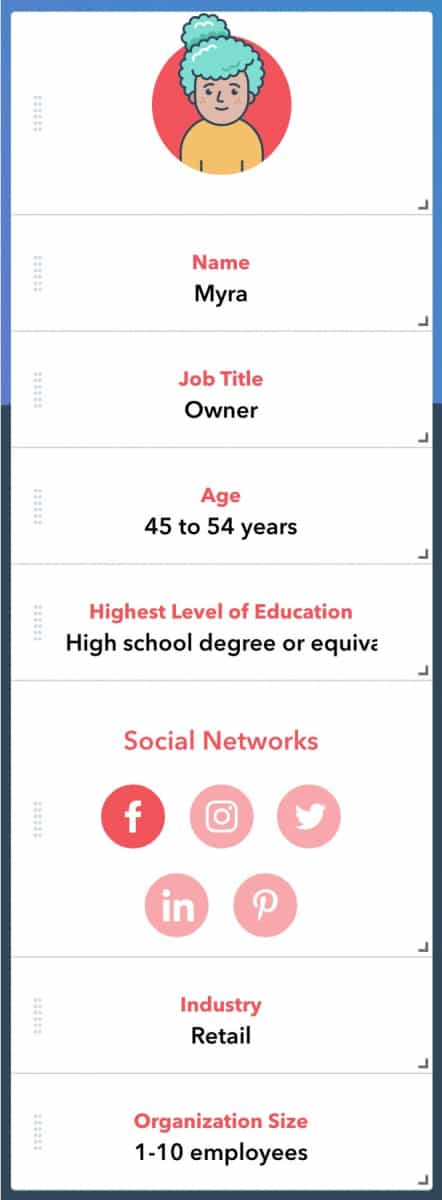
Myra owns a successful retail store. But its success means growing complexity – and she doesn’t know how to manage it, as she’s not very computer savvy, and doesn’t have many systems in place. Managing and motivating employees is also getting more challenging.
Alan’s an electrician. He’s recently taken on a couple of employees, but isn’t sure how to manage job costings, stock levels, and manage projects now he’s got more team members to worry about.
Michelle’s a graphic designer. She’s just started freelancing, and realised it’s not as straightforward as she thought. Her particular challenges are around cash flow/taxation, pricing, and profitability.
In the examples above, the personas all have a problem they want to solve. But their motivation could just as easily be an opportunity: e.g. opening a new store, investing some money, or importing a new product line.
Bonus tip: rank your buyer personas
Once you’ve identified your buyer personas, rank them to prioritise where your best profit potential is.
In this instance, Myra and Alan may be the best personas to target, as they will likely have the funds to pay a business coach over a period of time. Whereas Michelle, as a sole trader, is likely to be strapped for funds, or only able to afford the business coach for a very short time.
Here are criteria and considerations to help you rank the viability your buyer personas:
- Is that particular segment big enough to be profitable?
- Can you reach that buyer persona easily with your marketing?
- And can you do so profitably?
- Is that segment suitably stable?
Step 2: What information needs do your buyer personas have at the different stages of the buying cycle?
Here are the different stages of the buying cycle (also known as the buyer’s journey) – each is illustrated with Myra’s journey as an example of the meaning of each of these stages.
- Awareness: Myra realises she’s losing sales, because she’s consistently out of stock of key products, and starts researching stock management topics online.
- Consideration: Fast forward one month, and Myra’s stock management issues are getting worse. She’s researched stock management topics numerous times, but she realises that the level of computer knowledge is far beyond her skills, and she realises she needs help. She’s identified a shortlist of people and companies that might be able to help her. She may even have had some free consultations with her two favourite consultants.
- Decision: Myra’s received your proposal, and has decided to engage you to help her.
- Retention: It’s at least 7 times more expensive to find a new customer than it is to keep hold of an existing customer. So it’s logical that you keep in touch with Myra. In addition to the consulting meetings, add value to the relationship by sending her additional resources (e.g. via a client-only newsletter), and show that you appreciate her by sending a thank-you card or offering a loyalty programme.
Note that the nuances of the buying cycle will vary from product to product, and from service to service. As will the length of time that’s spent on each stage.
For example, choosing a builder for your new home is a lot more involved than buying a new toaster.
Each stage of the buying cycle requires different types of content
Now that you understand the stages of the buying cycle, consider the content/marketing needs for each stage.
Here are some of the marketing channels for each stage of the buying cycle:
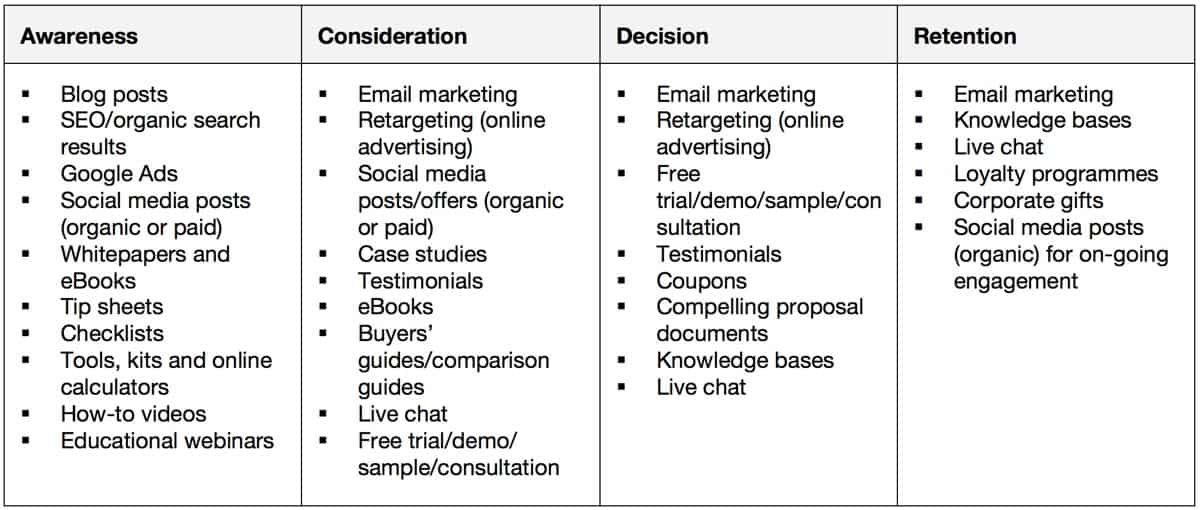
These are generic lists – you will need to consider what’s relevant for your business.
So your next job is to decide which tactics you want to concentrate on.
Go on – write your shortlist!
Step 3: Create your content map
You now have your:
- Buyer personas.
- List of marketing tactics you want to use at each stage of the buying cycle.
This is where we put it all together in a content map.
This is just a simple grid system:
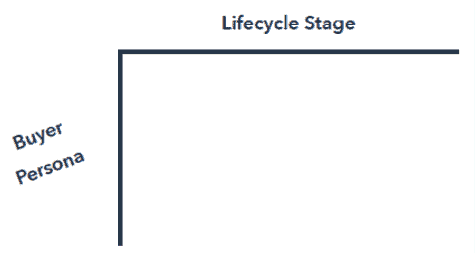
The best way to put the content map together is in a table or spreadsheet.
Here is the basic format of a content map. To fill it in, you will need to have your notes and ideas from the previous steps handy:
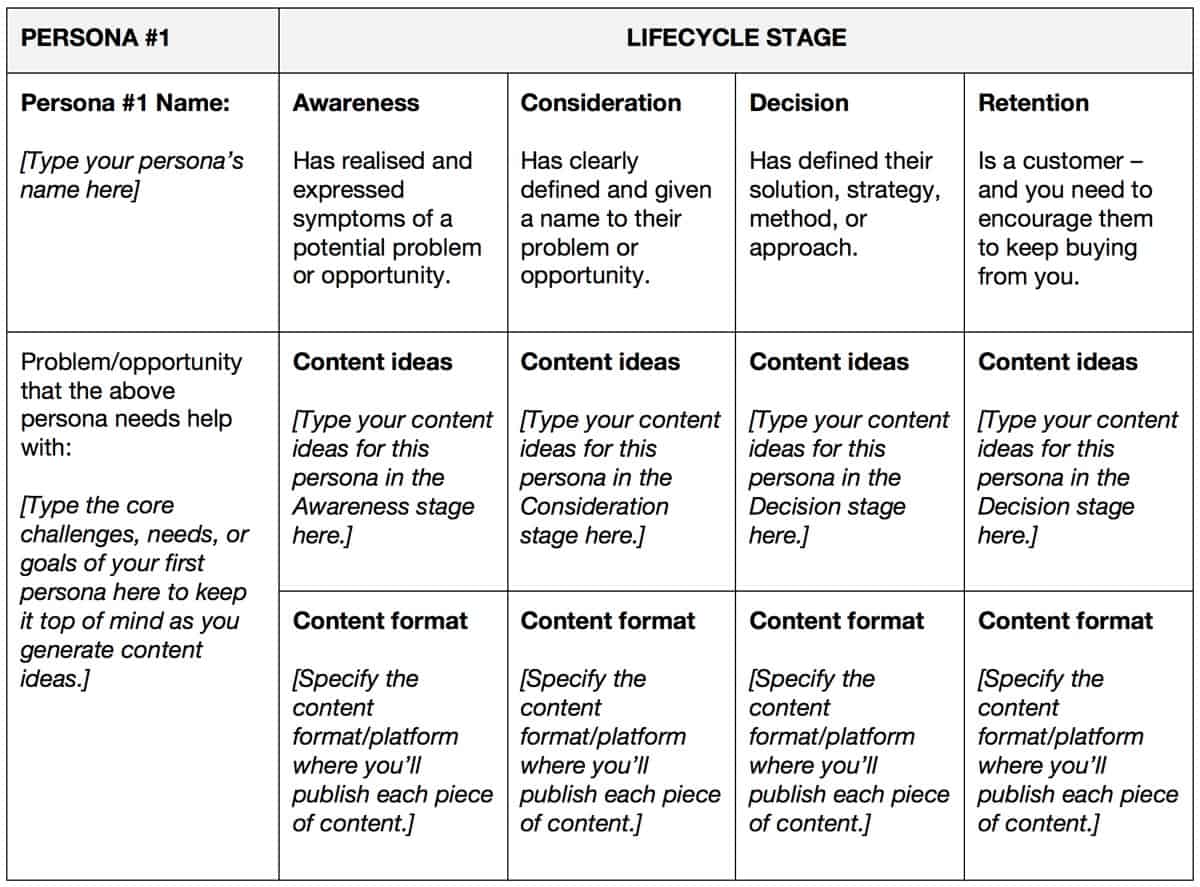
Download your FREE content map template (in Word/docx format).
Here’s a filled in content map example for Myra, our retail store owner, who’s looking for someone to help her get better systems and processes set up:
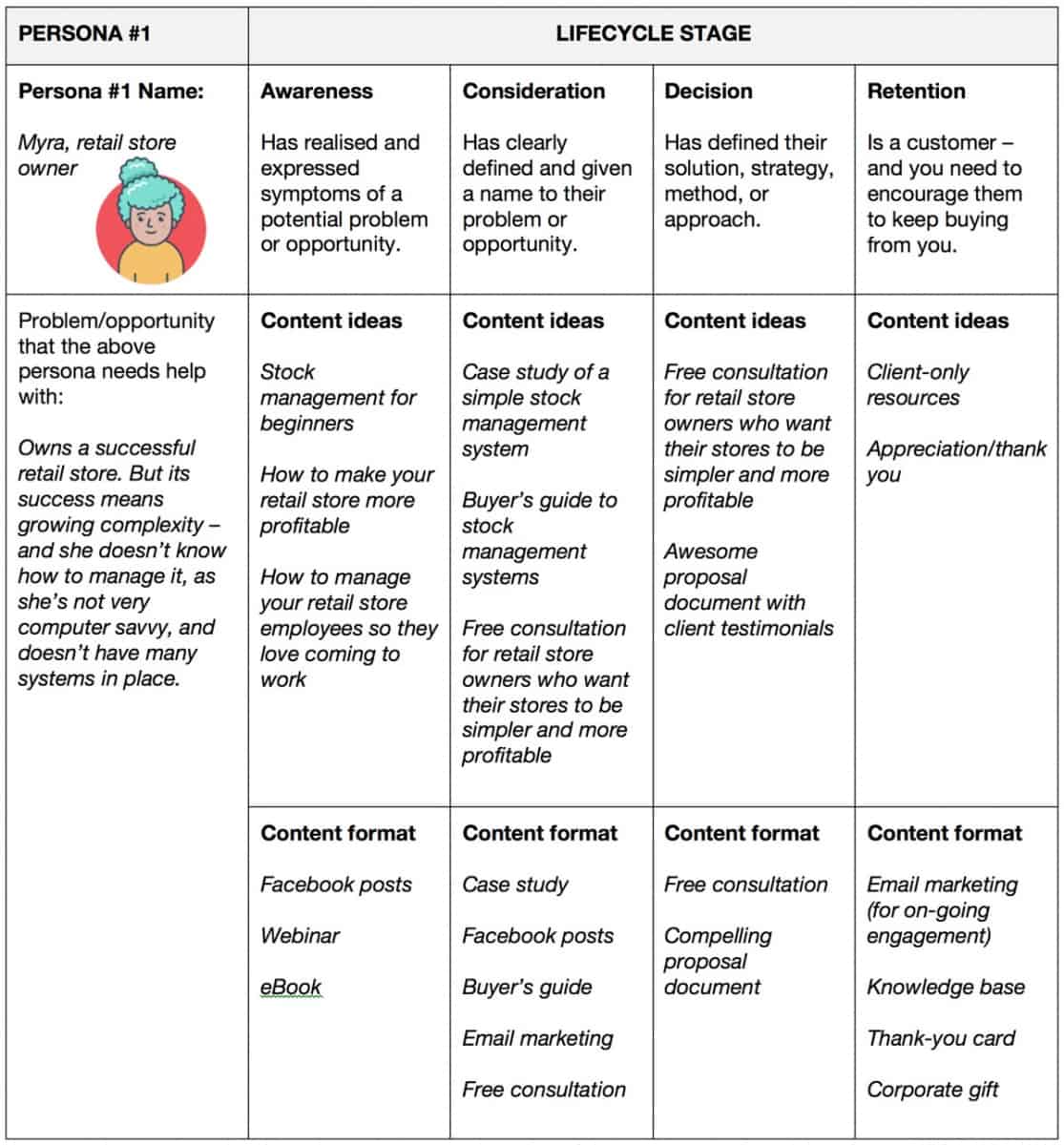
Wow – doesn’t that kind of content map provide you with a huge amount of clarity!
Now complete the content mapping exercise for each of your buyer personas.
As per the content map example we’ve worked through here, you may notice that content formats overlap some of the stages – and that’s absolutely fine.
At least this way you know WHY you’re posting on social media (for example), and WHAT you should be posting. This approach will give you a lot of clarity with not just the content you produce, but the channels and formats you’re using.
Step 4: Create your content
You now have your content mapped out to cover all your buyer personas at all stages of the buying cycle. Well done!
You may feel a little daunted at just how much there is to do.
To stop the overwhelm, do a gap analysis and look at the content you’ve already got:
- Are some buyer personas already quite well covered?
- Are there stages of the buying cycle where there are obvious content gaps?
- If you have a CRM system for your sales, analyse at what part of the funnel you’re having the most challenges: is it getting leads? Or converting those leads? This content mapping model translates well to the sales funnel, so be sure to overlay the two if you can.
Work out what you’re strong on, and where your gaps are.
Then prioritise your content generation, so you’re focusing on areas that (a) have the biggest gaps or challenges, and (b) the biggest potential returns.
Summary
The content mapping process promotes strategic content creation. This way, your limited time and other resources can be focused on priority areas.
The steps involved in creating a content map are:
- Identify your buyer personas.
- Identify the information needs your buyer personas have at the different stages of the buying cycle.
- Create your content map.
- Create your content.

Next step: Do you need help with content mapping? I work on this with clients face-to-face in a one-on-one content mapping workshop. Available throughout Northland and Auckland, New Zealand. Contact me to find out more.
Or if you’ve got your content mapped out, and need someone to write it, check out my article writing services. I work with clients worldwide on their content writing.



